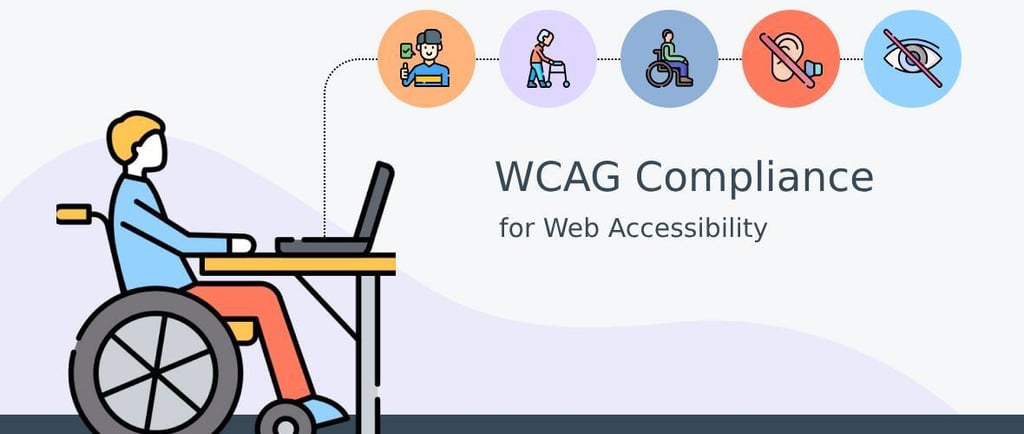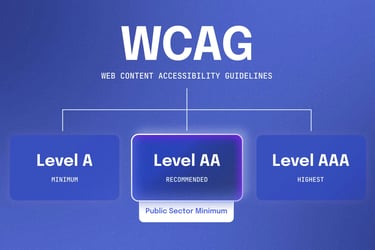Website Accessibility Explained
COMPLIANCE HELP
Nicola Tierney
9/9/20257 min read


Website Accessibility Explained
What It Is, Why It Matters, and How to Test Your Site
(Free Tools Included)
If you run a business website in the UK, you've probably heard the term "accessibility" thrown around, especially if you work with public sector organisations or government contracts.
But what does it actually mean? And more importantly, is your website accessible?
In this guide, I'll break down:
What website accessibility is (in plain English)
Why it matters for your business
The UK legal requirements
How to test your site with free tools
Common issues and how to fix them
No jargon. No overwhelm. Just practical advice you can use today.
What Is Website Accessibility?
Simple definition:
Website accessibility means making your website usable for everyone, including people with disabilities.
This includes people who:
Are blind or have low vision (use screen readers)
Are deaf or hard of hearing (need captions on videos)
Have motor impairments (can't use a mouse, navigate with keyboard only)
Have cognitive disabilities (dyslexia, learning difficulties)
Are older adults (may have age-related impairments)
In the UK alone, there are over 14 million people with disabilities. That's 1 in 5 people who might struggle to use your website if it's not accessible.
Think of it this way:
If your physical shop had stairs but no ramp, wheelchair users couldn't enter. An inaccessible website is the digital equivalent- you're unintentionally locking people out.
Why Does Accessibility Matter?
1. It's the Law (For Public Sector)
In 2018, the UK introduced the Public Sector Bodies (Websites and Mobile Applications) Accessibility Regulations.
What this means:
All government websites must be accessible
Local councils, NHS, schools, universities—all must comply
Websites must meet WCAG 2.1 AA standards (more on this below)
Non-compliance can result in legal action
If you work with government or public sector clients, accessibility compliance is non-negotiable.
2. It's Good for Business
Even if you're not in the public sector, accessibility makes business sense:
Larger audience - 14 million disabled people in the UK = potential customers
Better SEO - Many accessibility practices (alt text, clear headings, fast loading) also improve search rankings
Improved user experience - Accessible sites are easier for EVERYONE to use
Legal protection - Private sector businesses can be sued under the Equality Act 2010
Competitive advantage - Most small business websites aren't accessible—stand out by doing it right
3. It's the Right Thing to Do
Beyond legal and business reasons, accessibility is about inclusion. Everyone deserves equal access to information, services, and opportunities online.
What Are WCAG 2.1 AA Standards?
WCAG = Web Content Accessibility Guidelines
It's the international standard for web accessibility, created by the W3C (World Wide Web Consortium).
There are 3 levels:
Level A - Basic accessibility (minimum)
Level AA - Standard accessibility (UK government requirement)
Level AAA - Enhanced accessibility (gold standard, rarely required)
WCAG 2.1 AA is what you need to aim for in the UK.
What Does an Accessible Website Look Like?
Here are some key requirements:
1. Alt Text on Images
Every image needs a text description so screen readers can describe it to blind users.
Example:
html
Copy code
<img src="team-photo.jpg" alt="DNA Digital HQ team celebrating project launch">
Bad example:
html
Copy code
<img src="image1.jpg" alt="image">
2. Color Contrast
Text must have enough contrast against the background to be readable.
Good: Black text on white background (high contrast)
Bad: Light grey text on white background (fails contrast requirements)
Minimum ratio required:
4.5:1 for normal text
3:1 for large text (18pt+)
3. Keyboard Navigation
Users must be able to navigate your entire site using only a keyboard (no mouse).
How to test: Unplug your mouse and try navigating with
Tab - Move between links/buttons
Enter - Activate links/buttons
Arrow keys - Scroll or move through menus
If you get stuck or can't reach something, it's not accessible.
4. Form Labels
Every form field needs a clear label so screen readers know what it's for.
Good:
html
<label for="email">Email Address:</label> <input type="email" id="email" name="email">
Bad:
html
<input type="email" placeholder="Enter email">
(Placeholders disappear when you start typing, not accessible)
5. Heading Structure
Use proper heading hierarchy (H1, H2, H3) to organize content.
Good structure:
H1: Page title
H2: Main sections
H3: Subsections
Bad structure:
H1: Page title
H3: Section (skipped H2)
H2: Subsection (out of order)
Screen readers use headings to navigate, so proper structure is essential.
6. Video Captions
All videos must have captions for deaf or hard-of-hearing users.
YouTube auto-captions are NOT enough (they're often inaccurate). Use proper captions or transcripts.
7. Resizable Text
Users must be able to zoom text to 200% without breaking the layout.
How to test: Press Ctrl + Plus (+) on Windows or Cmd + Plus (+) on Mac to zoom. Does the layout break? Does text overlap or disappear?
8. Focus Indicators
When you tab through a page, there must be a visible outline showing where you are.
Example: Blue outline around the current link or button.
Test: Tab through your site. Can you see where you are at all times?
How to Test Your Website (Free Tools)
You don't need to be a developer or accessibility expert to check your site. Here are free tools anyone can use:
1. WAVE (Web Accessibility Evaluation Tool)
What it does: Scans your page and highlights accessibility issues with visual icons.
How to use:
Go to wave.webaim.org
Enter your website URL
Click "WAVE this page"
Review the results (red = errors, yellow = warnings)
Or install the browser extension for instant testing on any page.
Cost: Free
2. Axe DevTools
What it does: Browser extension that audits accessibility and provides detailed reports.
How to use:
Install the extension (Chrome, Firefox, Edge)
Open your website
Right-click → Inspect → Axe DevTools tab
Click "Scan All of My Page"
Review issues with explanations and how to fix them
Cost: Free (Pro version available but not necessary)
3. Lighthouse (Built into Chrome)
What it does: Audits performance, SEO, and accessibility.
How to use:
Open your website in Chrome
Right-click → Inspect → Lighthouse tab
Select "Accessibility" and click "Generate report"
Review your score and recommendations
Cost: Free (built into Chrome)
4. Color Contrast Checker
What it does: Tests if your text has enough contrast against the background.
How to use:
Enter your text color and background color (hex codes)
See if it passes WCAG AA standards
Cost: Free
5. Screen Reader Testing
What it does: Lets you experience your site the way blind users do.
Free screen readers:
NVDA (Windows) - nvaccess.org
VoiceOver (Mac) - Built into macOS (press Cmd + F5 to activate)
How to test:
Turn on the screen reader
Navigate your site using only the keyboard
Listen to what's announced—does it make sense?
Cost: Free
6. Keyboard Navigation Test
What it does: Tests if your site is usable without a mouse.
How to test:
Unplug your mouse (or just don't use it)
Use Tab, Enter, and Arrow keys to navigate
Can you reach everything? Can you complete tasks (fill forms, click buttons)?
Cost: Free (just your time)
Common Accessibility Issues (And How to Fix Them)
Here are the most common problems I see on small business websites:
Issue #1: Missing Alt Text on Images
Problem: Screen readers can't describe images without alt text.
How to fix:
Add descriptive alt text to every image
Decorative images (logos, design elements) can have empty alt text: alt=""
Example:
html
<img src="product.jpg" alt="Handmade wooden dining table with oak finish">
Issue #2: Poor Color Contrast
Image ByThe Myths of Color Contrast Accessibility
Problem: Light text on light backgrounds is hard to read.
How to fix:
Use the Color Contrast Checker tool
Aim for at least 4.5:1 ratio for normal text
Darken text or lighten background until it passes
Issue #3: Forms Without Labels
Problem: Screen readers can't tell users what each field is for.
How to fix:
Add proper <label> tags to all form fields
Don't rely on placeholders alone
Example:
html
<label for="name">Full Name:</label> <input type="text" id="name" name="name">
Issue #4: No Keyboard Navigation
Problem: Users can't navigate without a mouse.
How to fix:
Ensure all interactive elements (links, buttons, forms) are keyboard accessible
Test by tabbing through your site
Add :focus styles so users can see where they are
Issue #5: Videos Without Captions
Problem: Deaf users can't understand video content.
How to fix:
Add captions to all videos (YouTube, Vimeo have built-in tools)
Provide transcripts for audio-only content
Issue #6: Broken Heading Structure
Problem: Screen reader users can't navigate properly.
How to fix:
Use headings in order (H1 → H2 → H3)
Don't skip levels
Only one H1 per page (usually the page title)
Quick Accessibility Checklist
Use this checklist to audit your website:
Images & Media:
All images have descriptive alt text
Decorative images have empty alt text (alt="")
Videos have captions
Audio content has transcripts
Text & Color:
Text has sufficient color contrast (4.5:1 minimum)
Text can be resized to 200% without breaking layout
Information isn't conveyed by color alone
Navigation:
Site is fully navigable with keyboard only
Focus indicators are visible when tabbing
No keyboard traps (can't get stuck)
Skip-to-content link for screen readers
Structure:
Proper heading hierarchy (H1, H2, H3 in order)
Logical reading order
Landmarks (header, nav, main, footer) used correctly
Forms:
All form fields have labels
Error messages are clear and helpful
Required fields are clearly marked
Links & Buttons:
Link text is descriptive (not "click here")
Buttons have clear labels
Links and buttons are large enough to click (minimum 44x44 pixels)
What If My Site Fails?
Don't panic! Most websites have accessibility issues, you're not alone.
What to do:
Prioritise - Fix critical errors first (missing alt text, poor contrast, keyboard traps)
Learn as you go - You don't need to be perfect overnight
Get help - Hire an accessibility expert if needed (or contact me!)
Document progress - Keep a record of what you've fixed and what's still to do
For public sector work: You'll need an accessibility statement on your website explaining your compliance status and any known issues.
Resources to Learn More
Free Courses:
WebAIM - webaim.org (Best free resource)
W3C Web Accessibility Initiative - w3.org/WAI (Official WCAG docs)
Google's Web Accessibility course - Free on Coursera
Testing Tools:
WAVE - wave.webaim.org
Axe DevTools - deque.com/axe
Lighthouse - Built into Chrome DevTools
Communities:
A11y Project - a11yproject.com (Beginner-friendly)
WebAIM Discussion List - Great for questions
Final Thoughts
Website accessibility isn't just a legal checkbox - it's about making the web usable for everyone.
Start small:
Run a WAVE scan
Fix missing alt text
Check color contrast
Test keyboard navigation
Every improvement makes a difference.
And if you're working with government or public sector clients, accessibility compliance isn't optional - it's essential.
[Get in touch →]






Leave Nicola a comment ...
Connect
Get in touch for tailored solutions.
info@dnadigitalhq.com

🌿Quick Links
© 2025. All rights reserved. DNA Digital HQ | Company No: SC864001| Registered in Scotland, England & Wales
